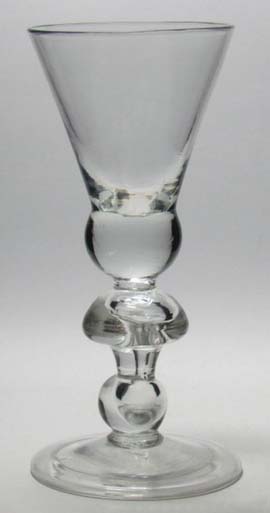Heavy baluster glass facts for kids
Heavy baluster glasses are a type of fancy drinking glass, like a goblet, that was very popular between the years 1680 and 1740. The name "baluster" comes from the French word 'balustre', which means 'pomegranate flower'. This name was chosen because the stem of the glass looked a bit like the shape of a baluster, which is a short, decorative pillar often found in railings.
What Are Baluster Glasses?
These special glasses got their name from their unique stem design. The stem, called a baluster stem, was made in one piece with the top part of the glass, called the bowl. It then tapered, or got thinner, towards the bottom.
To make them even more decorative, glassmakers added "knops" or "knobs" to the stems. These were decorative bumps or shapes formed right into the glass stem.
How They Changed Over Time
Originally, the stems of baluster glasses were wider at the bottom, just below the bowl, and then swelled out towards the foot (the base). However, people found these shapes a bit hard to hold. So, the design changed to an "inverted baluster," where the swelling was at the top, making it easier to grip.
After about 1720, the style of these glasses started to change. The heavy baluster glasses became thinner and lighter. Their stems also became more delicate, with smaller knops. These newer, lighter versions were known as light balusters or balustroids.
Why Did They Change?
One interesting reason for the change in glass design was taxes! In the 1700s, taxes were sometimes charged based on how much the glass weighed. This meant that heavier glasses cost more. To avoid these higher taxes, glassmakers started making lighter glasses. This led to smaller knops and more elegant, less bulky designs.
When the knops became so small that they were just slight swellings in the stem, the term balustroid was used to describe these very refined glasses.


